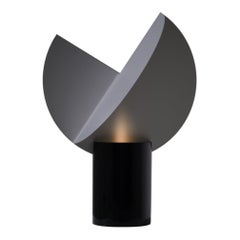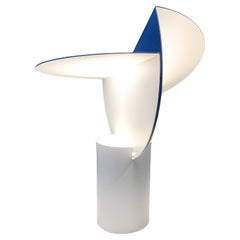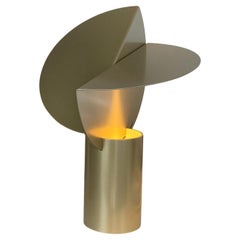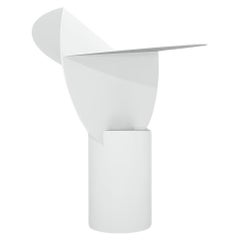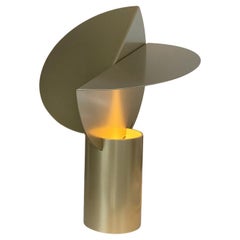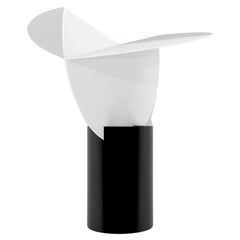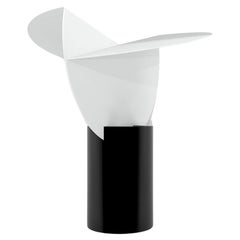Carlo Nason Ala Table Lamp
Vintage 1970s Italian Mid-Century Modern Table Lamps
Aluminum
Vintage 1960s Belgian Mid-Century Modern Table Lamps
Metal
Vintage 1960s Belgian Mid-Century Modern Table Lamps
Metal
Vintage 1960s Belgian Mid-Century Modern Table Lamps
Metal
Vintage 1960s Belgian Mid-Century Modern Table Lamps
Metal
Vintage 1960s Belgian Mid-Century Modern Table Lamps
Metal
Vintage 1960s Belgian Mid-Century Modern Table Lamps
Metal
People Also Browsed
2010s Dutch Modern Side Tables
Marble
21st Century and Contemporary American Chandeliers and Pendants
Brass
2010s British Scandinavian Modern Tables
Mohair, Oak
2010s South African Minimalist Pedestals
Hardwood
21st Century and Contemporary Swedish Scandinavian Modern Wall Lights an...
Metal
2010s American Modern Side Chairs
Aluminum
Vintage 1920s German Table Lamps
Nickel
21st Century and Contemporary Swedish Mid-Century Modern Table Lamps
Textile
Vintage 1960s Italian Mid-Century Modern Chairs
Metal
2010s Spanish Metalwork
Brass, Chrome
2010s Italian Side Tables
Onyx
Vintage 1970s Italian Modern Beds and Bed Frames
Leather
Vintage 1960s Italian Table Lamps
Murano Glass
Vintage 1970s Italian Mid-Century Modern Table Lamps
Metal, Brass
Vintage 1960s Italian Space Age Table Lamps
Glass, Art Glass, Blown Glass, Murano Glass
Vintage 1920s Dutch Art Deco Chairs
Fabric, Birch
Carlo Nason for sale on 1stDibs
A mid-century modern reference for today’s Murano glassmakers, Carlo Nason influenced the current tradition of glassmaking on an island renowned for it for hundreds of years. Celebrated for their exceptional designs, Nason’s lighting fixtures are sought after by collectors worldwide.
Learning to design and craft pieces from the family vetreria — rather than partaking in any formal training — Nason was working with the maestros at his family’s company furnace, V. Nason & C., attached to their family home by the time he was 11 years old. Although his roots are in Murano glassmaking, he took inspiration from the clean lines and natural colors of the Japanese metal vases he had seen in his youth at Milanese fairs.
Wanting to produce modern glass lamps, Nason worked with his family friend Gianni Mazzega of Mazzega Murano. For his Cascata chandelier (Italian for “waterfall”), which debuted in the 1960s, Nason achieved the effect of cascading water through an inverted pyramid of hanging glass plates, each individually mouth-blown and suspended from a chrome-plated frame for a dazzling, Art Deco–styled display.
The 1970s and 1980s were productive and creative years for Nason as the sole and independent designer at Mazzega Murano. His prolific career has also seen him design for other lighting manufacturers like I TRE, Murano Due and Kalmar.
After a mere four years as a glassmaker, Carlo Nason had his creations displayed at the Corning Museum of Glass in New York. The credit for the artisan’s pieces that were included in “Glass 1959” went to his family’s company, but the designs were all authored by Carlo.
Stepping away from the traditional, vibrant Murano stylings, Nason kept true to his inspiration, working with modern and simple forms that are relatively free of color. Nason told Palainco in a rare 2019 interview that his emotions inspired the shapes. And his legacy includes fixtures that are irreplicable and unreproducible, too — Nason made lighting pieces with multiple layers of glass that would be too costly or difficult to recreate today, and some designs were made with processes and materials now unavailable or banned in the glassmaking world.
Find an array of vintage Carlo Nason table lamps, floor lamps, decorative objects and more on 1stDibs.
A Close Look at Mid-century-modern Furniture
Organically shaped, clean-lined and elegantly simple are three terms that well describe vintage mid-century modern furniture. The style, which emerged primarily in the years following World War II, is characterized by pieces that were conceived and made in an energetic, optimistic spirit by creators who believed that good design was an essential part of good living.
ORIGINS OF MID-CENTURY MODERN FURNITURE DESIGN
- Emerged during the mid-20th century
- Informed by European modernism, Bauhaus, International style, Scandinavian modernism and Frank Lloyd Wright’s architecture
- A heyday of innovation in postwar America
- Experimentation with new ideas, new materials and new forms flourished in Scandinavia, Italy, the former Czechoslovakia and elsewhere in Europe
CHARACTERISTICS OF MID-CENTURY MODERN FURNITURE DESIGN
- Simplicity, organic forms, clean lines
- A blend of neutral and bold Pop art colors
- Use of natural and man-made materials — alluring woods such as teak, rosewood and oak; steel, fiberglass and molded plywood
- Light-filled spaces with colorful upholstery
- Glass walls and an emphasis on the outdoors
- Promotion of functionality
MID-CENTURY MODERN FURNITURE DESIGNERS TO KNOW
- Charles and Ray Eames
- Eero Saarinen
- Milo Baughman
- Florence Knoll
- Harry Bertoia
- Isamu Noguchi
- George Nelson
- Danish modernists Hans Wegner and Arne Jacobsen, whose emphasis on natural materials and craftsmanship influenced American designers and vice versa
ICONIC MID-CENTURY MODERN FURNITURE DESIGNS
- Eames lounge chair
- Nelson daybed
- Florence Knoll sofa
- Egg chair
- Womb chair
- Noguchi coffee table
- Barcelona chair
VINTAGE MID-CENTURY MODERN FURNITURE ON 1STDIBS
The mid-century modern era saw leagues of postwar American architects and designers animated by new ideas and new technology. The lean, functionalist International-style architecture of Le Corbusier and Bauhaus eminences Ludwig Mies van der Rohe and Walter Gropius had been promoted in the United States during the 1930s by Philip Johnson and others. New building techniques, such as “post-and-beam” construction, allowed the International-style schemes to be realized on a small scale in open-plan houses with long walls of glass.
Materials developed for wartime use became available for domestic goods and were incorporated into mid-century modern furniture designs. Charles and Ray Eames and Eero Saarinen, who had experimented extensively with molded plywood, eagerly embraced fiberglass for pieces such as the La Chaise and the Womb chair, respectively.
Architect, writer and designer George Nelson created with his team shades for the Bubble lamp using a new translucent polymer skin and, as design director at Herman Miller, recruited the Eameses, Alexander Girard and others for projects at the legendary Michigan furniture manufacturer.
Harry Bertoia and Isamu Noguchi devised chairs and tables built of wire mesh and wire struts. Materials were repurposed too: The Danish-born designer Jens Risom created a line of chairs using surplus parachute straps for webbed seats and backrests.
The Risom lounge chair was among the first pieces of furniture commissioned and produced by celebrated manufacturer Knoll, a chief influencer in the rise of modern design in the United States, thanks to the work of Florence Knoll, the pioneering architect and designer who made the firm a leader in its field. The seating that Knoll created for office spaces — as well as pieces designed by Florence initially for commercial clients — soon became desirable for the home.
As the demand for casual, uncluttered furnishings grew, more mid-century furniture designers caught the spirit.
Classically oriented creators such as Edward Wormley, house designer for Dunbar Inc., offered such pieces as the sinuous Listen to Me chaise; the British expatriate T.H. Robsjohn-Gibbings switched gears, creating items such as the tiered, biomorphic Mesa table. There were Young Turks such as Paul McCobb, who designed holistic groups of sleek, blond wood furniture, and Milo Baughman, who espoused a West Coast aesthetic in minimalist teak dining tables and lushly upholstered chairs and sofas with angular steel frames.
Generations turn over, and mid-century modern remains arguably the most popular style going. As the collection of vintage mid-century modern chairs, dressers, coffee tables and other furniture for the living room, dining room, bedroom and elsewhere on 1stDibs demonstrates, this period saw one of the most delightful and dramatic flowerings of creativity in design history.
Finding the Right Table-lamps for You
Well-crafted antique and vintage table lamps do more than provide light; the right fixture-and-table combination can add a focal point or creative element to any interior.
Proper table lamps have long been used for lighting our most intimate spaces. Perfect for lighting your nightstand or reading nook, table lamps play an integral role in styling an inviting room. In the years before electricity, lamps used oil. Today, a rewired 19th-century vintage lamp can still provide a touch of elegance for a study.
After industrial milestones such as mass production took hold in the Victorian era, various design movements sought to bring craftsmanship and innovation back to this indispensable household item. Lighting designers affiliated with Art Deco, which originated in the glamorous roaring ’20s, sought to celebrate modern life by fusing modern metals with dark woods and dazzling colors in the fixtures of the era. The geometric shapes and gilded details of vintage Art Deco table lamps provide an air of luxury and sophistication that never goes out of style.
After launching in 1934, Anglepoise lamps soon became a favorite among modernist architects and designers, who interpreted the fixture as “a machine for lighting,” just as Le Corbusier had reimagined the house as “a machine for living in.” The popular task light owed to a collaboration between a vehicle-suspension engineer by the name of George Carwardine and a West Midlands springs manufacturer, Herbert Terry & Sons.
Some mid-century modern table lamps, particularly those created by the likes of Joe Colombo and the legendary lighting artisans at Fontana Arte, bear all the provocative hallmarks associated with Space Age design. Sculptural and versatile, the Louis Poulsen table lamps of that period were revolutionary for their time and still seem innovative today.
If you are looking for something more contemporary, industrial table lamps are demonstrative of a newly chic style that isn’t afraid to pay homage to the past. They look particularly at home in any rustic loft space amid exposed brick and steel beams.
Before you buy a desk lamp or table lamp for your living room, consider your lighting needs. The Snoopy lamp, designed in 1967, or any other “banker’s lamp” (shorthand for the Emeralite desk lamps patented by H.G. McFaddin and Company), provides light at a downward angle that is perfect for writing, while the Fontana table lamp and the beloved Grasshopper lamp by Greta Magnusson-Grossman each yield a soft and even glow. Some table lamps require lampshades to be bought separately.
Whether it’s a classic antique Tiffany table lamp, a Murano glass table lamp or even a bold avant-garde fixture custom-made by a contemporary design firm, the right table lamp can completely transform a room. Find the right one for you on 1stDibs.
